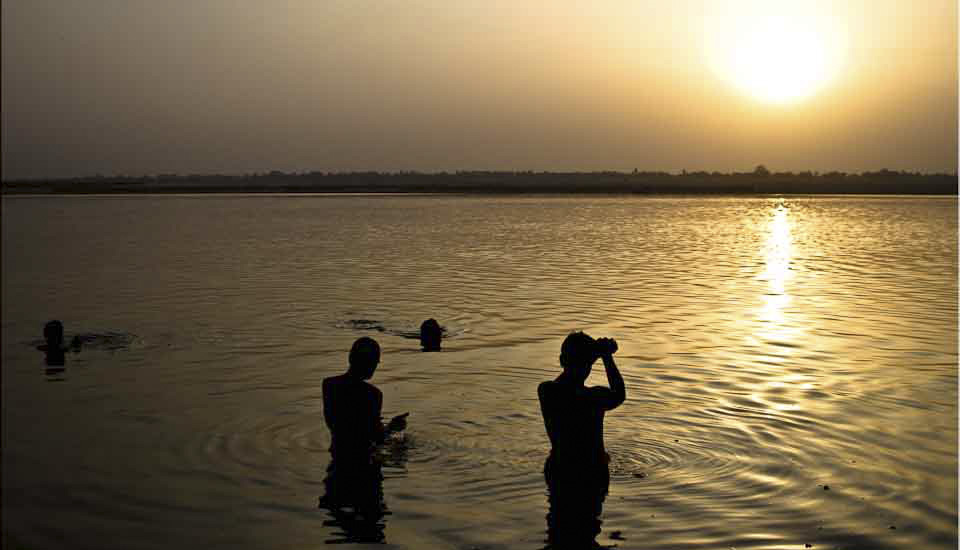.jpg)
Wangi Falls
One of the most popular attractions in Litchfield National Park in Australia’s Northern Territory, these magnificent falls are just one of several double-plunge waterfalls in the area.
So says the official Northern Territory (NT) Fact Sheet.
I hadn’t been in Australia’s expansive – and sparsely populated – central-northern regions for a long time (see: Colours in the Heart of Australia), and it had been even longer since I’d been to the country’s “Top End”. So, I was looking forward to a short stay in Darwin, the region’s capital and main population centre.
But, as much as I enjoyed walking around the city in “wet season”, I made sure to get out into one of the magnificent National Parks nearby. With only a short amount of time available to me, a day-trip to Litchfield – where I’d never been – seemed like the best option.
The park is about 120 km (75 mi) south-west of Darwin, and the bonus is that the roads there are mostly paved. Myself, and two younger visitors from Germany, were picked up from our hotel early, and set off with a driver/guide in a small van.
No thinking required!
Our guide told us that the massive property was willed back to the Northern Territory government as a National Park by the owner, who didn’t want the pristine beauty of the area exploited by his offspring. I can’t corroborate that, but it was originally part of several pastoral leases in the region, and became a park in 1986. It was named for a Territory pioneer: pastoralist, gold miner, and explorer, Frederick Henry Litchfield.
However the Park happened, we can be very thankful that it was formed! It truly is a stunning area – and so accessible to Darwin.
.jpg)
Sunrise from my Room
Darwin has grown since I was last here 20 years ago, but the wet season skies are still dramatic and beautiful.
.jpg)
Scenes from the Bus : Water Buffalo (Bubalus Bubalis)
Our guide (who also farms) called these Indonesian water buffalo; their horns are shorter than those I’m used to seeing across Southeast Asia. Water buffalo were originally imported into the NT in the 19th century as working animals and for their meat. Today, they are often farmed for live export.

Cathedral Termite Mound
We made a couple of stops at convenience stores to allow us to buy our lunches; our first tourist stop was at a termite mound. Home to a colony of cathedral termites (Nasutitermes triodiae), this feat of architectural engineering – built from mud, plant parts, and termite saliva and feces – is over 50 years old.

St Andrews Cross Spider – Argiope Spp
The ripples on the termite mound are host to a few rather decorative spiders.

Florence Falls
Breathtakingly beautiful, the segmented falls on Florence Creek tumble down 64 metres (210 ft) from the sandstone Tabletop Plateau into a popular plunge-pool below.

On the Metal Walkway
Our guide took us along the Shady Creek Walk, which comprises a metal walkway and a lot of stairs.

Blue Spiderwort – Commelina Tuberosa
There were plenty of wildflowers to admire …

Under the Canopy
… as we worked our way through the woods …

Florence Creek
… and along the creek.

Grey-Headed Flying Foxes – Pteropus Poliocephalus
High in the palms overhead, nocturnal flying foxes roost: chattering and jostling continuously.

Around the Falls
The falls themselves – when we come to them – are beautiful.

Women in the Falls
My travel companions take full advantage of the pleasantly warm waters in the plunge pools.

Wet Walls
All around us, the sandstone walls rise steeply …

Fern on the Rock Face
… and plants cling to any crevices they find.

Rocks in the Creek
Running away from the rock pools, the creek tumbles over boulders …

Green Reflected
… and collects in small reflective pools.

Almost Abstract : Clear Waters in the Woods

Nature’s Artworks : Palm Tree Camouflage
I was told this is a Florence Falls palm (Hydriastele wendlandiana).

Into the Grass
The change from Monsoon Forest into Savanna Woodland along our walk away from the falls is as dramatic as it is surprising.

A Quiet Corner
And then – back into the woods!

Buley Rockhole – Upper Pools
A short drive away, we stop at the Buley Rockholes: beautifully clear, interconnected pools suitable for a plunge.

Over the Rocks
Being spring-fed, the Buley Rockhole waters are much cooler than those at the bathing spots under Florence Falls.

Buley Rockhole
A short while later as we leave the pools, we could see the dark clouds rolling in – carrying plenty of tropical rain.

Elephant Creeper – Argyreia Nervosa

Palms and Grasses
Our last stop within the park allows us a short walk along Wangi Creek …

Wangi Falls
… to another beautiful segmented waterfall.

Crocodile Trap
Wangi Falls is a popular recreation spot, but crocodiles are a very real risk factor, and the area is closed to swimmers after high rains.

Golden Orb Web Spider – Nephila Philipes
I love these beautiful, big, spiders.

Blue-Winged Kookaburra – Dacelo Leachii
I’m used to seeing laughing kookaburras (Dacelo novaeguineae), but watching a pair of these large kingfishers – native to northern Australia and southern New Guinea – chattering in the trees overhead, was a real treat.

Common Crow Butterfly – Euploea Core
It is always a joy for me to capture any wildlife – even these more common types!

Aside from a small freshwater crocodile in a tank at the pub we stopped at on our way out of the park, we didn’t see any crocs – which is fine with me! Dangerous – often fatal attacks – are not uncommon in the north of Australia.
Overall, it was a great day out, and I’d certainly put Litchfield National Park on a list of ‘must sees’ in Australia’s Top End.
Photos: 18March2025


































.png)

